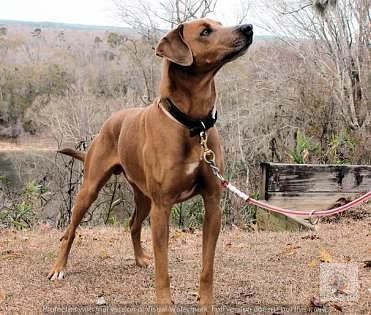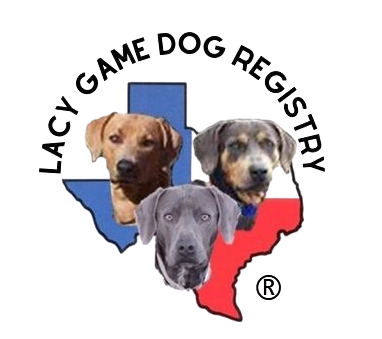
The Lacy Game Dog Registry, together with the Texas Lacy Game Dog Association, have compiled two presentations that we feel will help potential buyers to familiarize themselves with the history, breed standards and the separation of ideology from other registries that we hold to. Please take the time to listen to both presentations to learn about the background and standards that set this wonderful breed apart. Again, thank you for your time and interest in the Lacy Dog.
One Blue Lacy can do the work of three cow hands!
Having nothing to do with the characteristics the dogs have, the breed is named for the family that developed it. Arriving from Kentucky by covered wagon in the 1800’s, the Lacy Brothers, Frank, George, Ewen, and Harry Lacy settled in the Granite Hills near Marble Falls, Texas. Faced with the challenges of life on the frontier, the brothers had a true need for an all-around working dog. Burnet County’s natural resources yielded an abundance of acorns to free range feed cattle and hogs for market. This income stream along with the need to hunt and provide food on the table for their families was the rise of the Blue Lacy breed.
The resulting breed is noted to be the outcome of Greyhound, Scent Hound and Coyote Cross, with the emphasis on the herding/droving characteristics. Many people have their own theory on the Scent Hound and Coyote used, but whatever the scent hound or pariah dog was in the combination, it worked. The Lacy Brothers established this breed under the guidelines required to develop a recognized breed, and the State of Texas Honors The Blue Lacy as being the first known dog breed to originate in the State. As true a pioneer as the men you see in history books, for well over a century, the Blue Lacy has filled the needs of Colonial Americans. Ranchers throughout the southwestern United States utilized the breed’s multiple talents in a variety of ways. But in time, the three-wheeled horse hit the trail, bringing this unique breed unsuccessfully close to extinction.
The breed’s versatility was ultimately its salvation. While the need for its instinctive herding abilities was diminishing, a demand for its abilities to bay the fiercest hogs, pick up the trail of any game animal, or find a wounded animal on the slightest of blood trails was on the rise in the commercial hunting industry. No matter what the dog’s primary job is, Blue Lacy owners claim they are the perfect universal dog, knowing just where to be at just the right time!
Today, the breed survives strong through the efforts of the Texas Lacy Game Dog Registry, the Texas Lacy Game Dog Association and the men and women who contributed the documentation necessary to preserve its history.
The History of the Lacy Game Dog Registry
Jack Franks was the first owner of the Lacy Game Dog Registry. (Hereinafter referred to as the LGDR). Until 1987, Mr. Franks inspected and registered all Blue Lacy dogs within the LGDR. In 1987, the registry was sold to Raymond Trimble, who is credited for all the recorded registries from February 11, 1987 through April 13, 1990. At this time, he handed over the registry to Larry Boyd. Mr. Trimble and Mr. Boyd worked as government trappers for the Texas Wildlife Department and used Lacy’s to help them. Years after Mr. Boyd accepted responsibility for the registry, he contracted Lyme disease. Due to his illness, he was unable to meet registry demands. In October of 1998, Boyd passed the torch to Marlo Riley, great, great granddaughter of Frank Lacy, one of the original Lacy brothers who developed the breed. In December 2013, Marlo married Gary Ondrej and now signs all registries as Marlo Ondrej from that date on.
The History of the Texas Lacy Game Dog Association
The Texas Lacy Game Dog Association (hereinafter referred to as the TLGDA), was formed to work in unison with the LGDR to help preserve the Lacy Breed. It offers Lacy owners and others a community where members can share their interest in the breed. Members pay a small yearly fee and benefits include newsletters, access to the Texas Lacy Game Dog Association, a Facebook group, invitations to sponsored events, and very often, friendship. The TLGDA is also committed to educating new Lacy owners and those wanting to own Lacys, about the breed’s characteristics.
In 2000, Marlo Ondrej began gathering more documentation and reached out to other Lacy Family descendants. Family members Helen Gibbs, Granville Lacy, R.L. Metzger and Winifred Roque passed on historic photographs and documents. Especially of importance were the oral histories passed down from generation to generation.
Although not family members, other lifelong Lacy owners also helped Marlo document the breed’s history. Ruth Wilkes’s father was George Washington Lacy’s ranch foreman. She inherited some of the original Lacy land where she resided until her death. Her husband, H.C. Wilkes, is also credited with the Blue Lacy breed, and is listed in the Hall of Fame in Quinlan, Texas for his work.
Also credited by the registry is Tom Graham, Lee Ussery, Gary Larremore and Brian Larremore. These men owned Lacys from childhood, and supported the breed. Their efforts are reflected in the dogs you see today.
Facts about the Lacy Game Dog Registry and the Texas Lacy Game Dog Association
Here are a few facts you may want to know about the Registry and Association that set us apart:
The Lacy Game Dog Association and the Lacy Game Dog Registry are aligned and work together to maintain and preserve this amazing breed.
We are the only breed Registry and Association, so listed in the House Resolution 108 by the State of Texas.
The LGDR and the TLGDA are the Original and Official Registry and Association for the breed.
There are many individuals who were instrumental in getting the Blue Lacy recognized as the State Dog Breed of Texas.
The Blue Lacy breed was actually first recognized by the Texas Senate with SR No. 436 in 2001, once lobby efforts to honor the Lacy Brothers and the rich Texas heritage associated with the dog breed they developed had begun. Texas Senate Member Todd Staples presented SR No. 436 to the 77th Legislature which passed and was signed on March 8th, 2001. This was the first step and served to formally honor the Blue Lacy as a true Texas breed.
Lobby efforts continued, and in 2005, House Representative Joaquin Castro was the main Sponsor for HCR No. 108. Senators Jeff Wentworth and Leticia Van de Putte then signed on as Senate Sponsors for the bill.
The TLGDA, the LGDR, Lacy family descendants, and numerous TLGDA members worked hard to generate support and compile more documentation. Lacy family member Marlo Riley Ondrej was the primary lobbyist, supported by other Lacy family members: Jane Turman, Wayne Cavin, Doug Cavin, and Helen Gibbs.
In 2005 the legislature passed HCR 108. Former Governor Rick Perry made the State Dog Designation official on June 18, 2005.
You can learn more about the Blue Lacy by visiting the TLGDA website.
